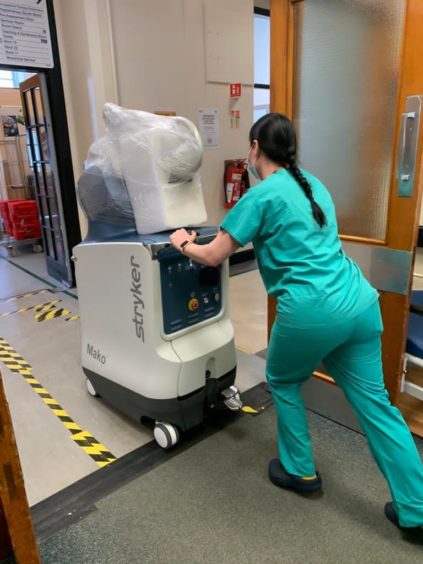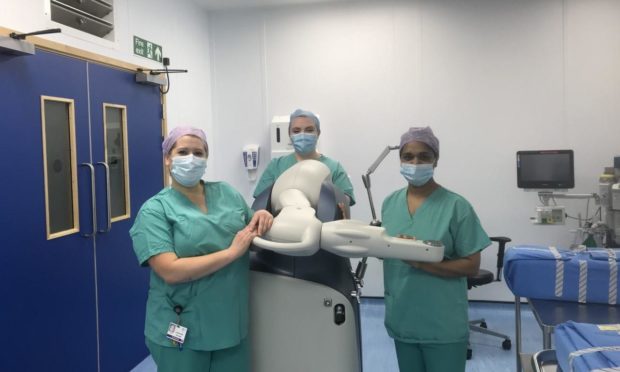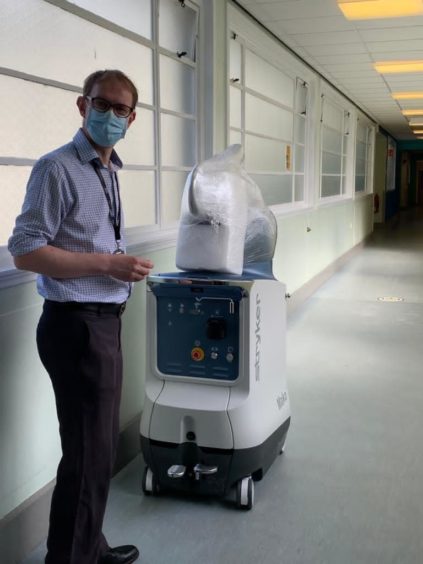NHS Grampian has become the first health board in Scotland to undertake a hip replacement using robotic surgery.
The procedure took place last month at Woodend Hospital in Aberdeen, under the care of orthopaedics consultant Scott Barker, with further robotic knee replacements also performed since.
Less post-operative pain, quicker recovery
Orthopaedic consultant and clinical lead for elective orthopaedic surgery Andrew Johnston said: “The robot arrived early last month and so far has been used during surgery for around 12 patients.
“As with most new technology, there have been some early teething issues as it has bedded in, but we are now starting to see the benefit for the patients and surgeons, in NHS Grampian, of using this equipment.
“For hip replacement patients the robot allows more accurate implant positioning.
“This will facilitate the expansion of the direct anterior approach, which minimises muscle damage, allowing quicker recovery.
“The first robotic-assisted procedure of this kind in Scotland was undertaken by my colleague Martin Mitchell earlier this week.”
Most patients who have had knee replacement have less post-operative pain, and quicker recovery times.
Mr Johnston said this allows extra capacity for surgeons to operate on more patients, freeing up beds since patients go home more quickly.
“Ultimately that lets us tackle waiting lists more quickly and helps us improve the quality of life for more patients in a shorter timeframe,” he added.
‘Robot allows surgeons to be more precise’
Woodend Hospital already has one of the shortest lengths of stays for patients in the country for knee and hip patients and it is hoped the new technology will improve this further.

Unit operational manager for surgery Sean Berryman said: “The surgeon is still very much carrying out the operation – the robot simply allows surgeons to be more precise, improving overall capacity and patient experience.
“We have six surgeons trained to use the orthopaedic robot so far, with two more being trained later this month. That number will continue to increase in the future.
“We very much hope trainees will be attracted to NHS Grampian because of the technology we are using and have available across our surgical division now.
“The orthopaedic robot is the fourth in the NHS Grampian fleet and they all contribute to improved patient care, our capacity and ensuring our surgeons have state-of-the-art tools to do their job to the highest standards.”
Vital boost to waiting times
Medics in the north-east were the first at a health board in Scotland to have a robotic-assisted surgical system in 2015.
The region’s original device – which will now be used for training surgeons – has been used for urology and gynaecology patients since 2015.
The latest additions will allow NHS Grampian to increase its robotic surgery offering to cover general surgery and other sub-specialities over time as well as developing other specialities.
Divisional general manager for surgery Cameron Matthew explained how he hoped the investment would benefit patients and surgeons in the region in future.
He said: “The hope is we will be able to develop a regional training centre and specialist robotic division.
“That in turn will hopefully attract robotic fellows to Aberdeen before they move on to substantive posts elsewhere, or indeed they decide to stay in the north-east.
“These machines will provide a boost to our waiting times and that is vital, especially as we move out of Covid-19 and look to tackle our waiting lists and we now have the best technology available to do that.
“As a health board, in getting these robots, we have ensured that the best tech is there to help us come out of Covid.”

